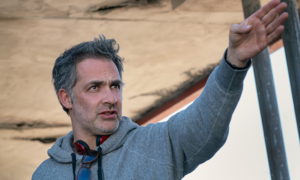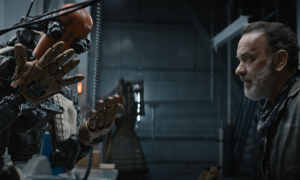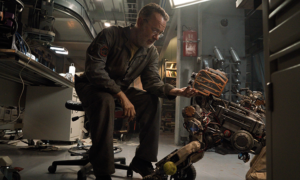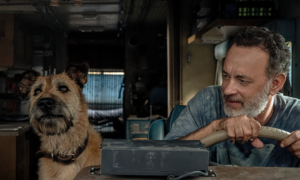As one of the last people on Earth, when robotics engineer Finch (Tom Hanks) realises he’s dying, he builds a robot to look after his beloved dog, Goodyear. Naming himself Jeff, the robot (Caleb Landry Jones), Finch, Goodyear and Dewey the robot dog, are soon forced to embark on a perilous journey into a desolate American West, where Finch strives to show his creation the joy and wonder of what it means to be alive.
Directed by Miguel Sapochnik (Game Of Thrones) and written by Craig Luck and Ivor Powell, Finch is a powerful and moving post-apocalyptic adventure of one man’s quest to ensure that his beloved canine companion will be cared for after he’s gone.
We spoke to Sapochnik about working with dogs, robots and dragons…
How did you first get involved with Finch?
Craig Luck, who is one of the writers of Finch, approached me with a short film called BIOS that he was planning on directing and he wanted some advice – it must have been 15 years ago now. I put him in touch with a bunch of people I’d worked with. Then years later, about seven years ago, I was approached by a very good friend of mine called Ivor Powell, who’s the other writer [of Finch], who had been one of the people I’d put Craig in touch with.
They’d ended up collaborating and written the feature version of BIOS, and they sent it to me. I read it and I was really struck by the lack of sentimentality in it. That it was very engaging, but it didn’t feel manipulative. So we decided to work together on it for a while. Then at some point, we realised we had to go out to the world, and just around that time, we had taken on some producers which was a company called Image Movers, which is Bob Zemeckis’ company.
They sent it to Tom Hanks and I got a phone call saying Tom Hanks is really interested in doing the movie. I didn’t really believe it [haha] so I spent a bunch of time not believing it, and then I went for a meeting at Tom’s production company, and we met, and we talked about stereos for like 30 minutes! He collects old vintage stereos and typewriters and we just talked about that stuff for ages, because I love that stuff as well.
Then we sat down and he goes ‘so, can I be in your movie?’ and I just kind of ignored that he just said he wanted to be in my movie and I launched into a pitch about how I really wanted him to be in this movie. Then like 10 minutes later in my brain started going ‘Miguel, shut up, he’s already said he wants to be in your movie, you don’t need to pitch this anymore’ and I shut up, and then he was in the film!

What was it like shooting a movie with just three characters?
It was really, really easy. It was a lovely change of pace from what I’d been doing because I’d been on season eight of Game of Thrones and so it’d been 25 cast members and hundreds of extras and dragons and battles and white walkers, so it was actually a really pleasurable shift in gears!
Tom was on set all the time. He’s got a chair he sits in, he goes to sleep in the chair, you say ‘Tom we’re ready’ and he gets up and he comes into the scene. The dog was there, being basically loved by everybody on set all the time, just sitting there and getting his neck scratched. Caleb was there all the time as well, who played Jeff. We definitely shot it like a small movie, and there was something very gratifying about that as an experience.
We’re guessing it was nice not to have dragons in this project as they’re notoriously hard to work with…
They really are. They always burn everything, it’s terrible!
So was Caleb Landry Jones on set for the whole shoot?
He was! Tom acted opposite Caleb in every single scene. The only time Caleb wasn’t on screen is when Finch first turns Jeff on and he’s a disembodied head. But Caleb was sitting underneath the table doing the voice for Jeff. So when you’re watching Jeff, what you’re seeing is Caleb Landry Jones, turned into a robot.

Did you have much input in designing Jeff?
My nerdy self would never have allowed a movie to be made with a robot in that I was directing without designing the robot. However, Tom Meyer, who’s the production designer and a very good friend of mine, came on board early on and he had also done a film called Real Steel. So he had had experience of making robots and making the digital world combined with the real world, so it was just a natural progression.
I was doing season eight of Game Of Thrones and every Sunday I would get on the phone with Tom and we would just spend hours going through all the designs. I would do lots of doodling and send him ideas. I think we did that for almost a year and then finally we settled into what we felt Jeff would be. This was before any pre-production was begun on the film, so Jeff had a lot of work done on him to become what he was.
At one point I think we actually reached a point where we found the design that Jeff would ultimately be and then we just sailed past it and kept going, trying all sorts of other things and at some point we realised; ‘Oh no, the design was there two months ago and we just, we’d missed it!’. We’d kept looking and so we came back and we settled into it. It was one of my favourite parts of the process actually.
How much of the robots were practical?
There’s a company called Legacy who built Dewey and Jeff as animatronics. Dewey was a remote control puppet that took six people to operate and had 50 servos. Basically everything in the film that is Dewey is a real moving puppet. There’s almost no CG when it comes to Dewey.
Jeff was also a puppet that they built that was fully animatronic but it had certain limitations. When Jeff the animated puppet came to set, it was huge. It was fully life-size and required six guys to be doing all the different movements. But as soon as Caleb showed up we realised that Jeff the animated puppet would never be able to do what Caleb was doing.
I’d heard these stories about Steven Spielberg sidelining all the animatronic puppets for Jurassic Park after they showed up on set and going down the digital route and I always thought ‘my god how could they have done that?’. Then I made this film and I realised why! You just suddenly realise that there’s no way it can ever capture the same feelings that an actor can.

What was it like creating the desolate world in Finch?
A majority of the inspiration was based on talking to scientists and futurists and experts in climate change about what the actual impact of a gamma flare would be. Also, it’s allegorical. Ultimately the idea of climate change and gamma flares are a super sped-up version of what climate change is ultimately doing, because it’s making huge holes in the ozone which is creating radiation, which is heating everything up.
So, we really tried to stay as close to reality as possible and not deviate unless it felt like it was working against our narrative. It actually very naturally evolved out of that. The biggest thing that we realised was there could be no vegetation whatsoever. So we had to go and find a location that had a minimal amount of vegetation and the only place in the United States that we could really find that was even in the ballpark of that was New Mexico, which is why we ended up there.
What are the main themes in Finch?
I always found the script to be quite funny and kind of unsentimental. The themes are quite adult but the audience we wanted to target were families. We would love the idea of parents and children going to see this movie.
It’s about growing up and growing old – those two things seem so at odds with each other and yet they’re so similar. They are also, sometimes, very lonely experiences. For a kid growing up and starting to learn all these things about the world and having all these questions and all these mysteries, it can be a very traumatic experience. For people who are growing old, feeling like nobody wants to hear what that experience is, and in a way, I think we have a tendency to shut that out. It’s as if growing old is wrong. And it’s not, it’s part of life.
So, I was hoping that by covering these two subjects with these two different characters, there’ll be an opportunity for conversation about that, even if it’s the smallest conversation. To be honest with you, my dream scenario is that a father and daughter or a father and son go see the movie and on the way home, they have a hug. That would be great.

How did you go about maintaining Finch’s heartfelt, humorous vibe alongside the perilous post-apocalyptic journey the characters go on?
I’ve always maintained that you make a film five times: You conceive and write the script. That’s time one. You prep the film. Which is go number two. Then you shoot the film. Which is go number three. Then you do post and editing on the film – number four. And then you market the film.
So each time you have an opportunity to re-examine the narrative that you’ve chosen, and tweak it and figure out whether you’re still on point with the message that you initially started with in your mind.
I think that really has been the case here. The film that it began as is not necessarily the film it ended up as, but hopefully, it is a response to the challenges that we faced when we were making it.
I honestly didn’t know whether we would be able to make a light-hearted, hopeful movie as much as I may have wanted to. I think my natural inclination has always been towards the darker side of human nature.
So for me it was a real challenge to see if I can make something that didn’t go dark and you can be the judge of [whether I succeeded]…
Finch is out now on Apple TV+. Read our review here.
